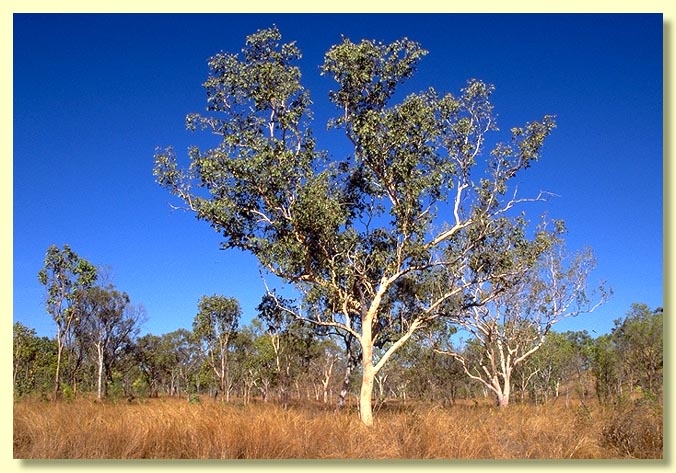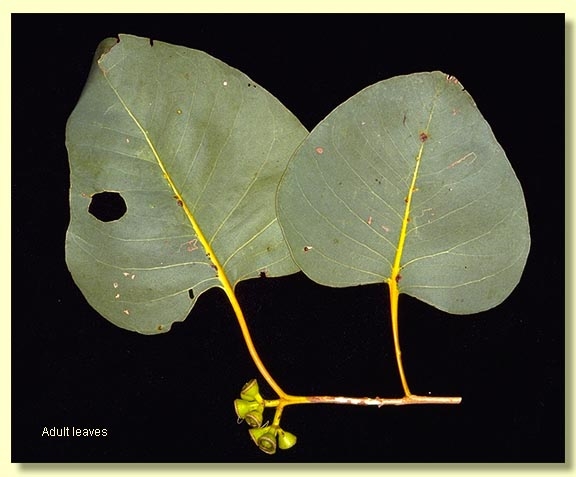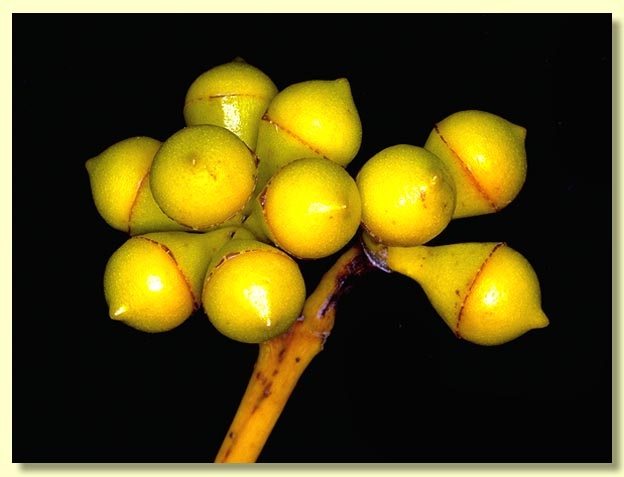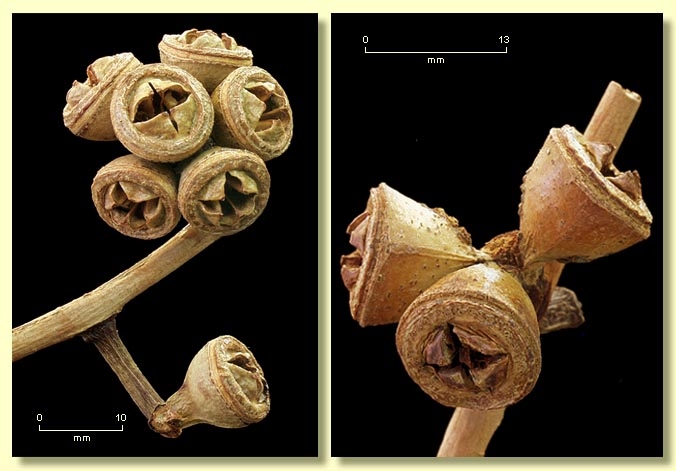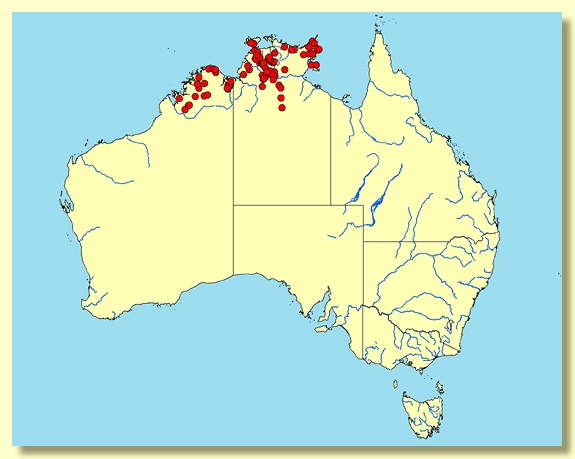Euclid - Online edition
Eucalyptus bigalerita
Eucalyptus | Symphyomyrtus | Exsertaria | Subexsertae | Applanatae
Eucalyptus bigalerita F.Muell., J. Proc. Linn. Soc., Bot. 3: 96 (1859).
T: W of Mataranka, near junction of King River, Dry River and Darrinyan Creek, Northern Territory, 3–5 July 1856, F. Mueller; holo: MEL; iso: K.
E. pastoralis S. Moore, J. Bot. 40: 27 (1902). T: Adelaide River, Northern Territory, July 1886, T.S.Lea s.n.; holo: BM; iso: NSW.
Tree to c. 17 m tall, often deciduous during the drier months prior to the wet season. Forming a lignotuber.
Bark smooth throughout, new bark pale orange to pale creamy-pink, maturing through brilliant salmon-pink to grey-white and weathering to grey just before decortication. Mature bark sometimes powdery.
Juvenile growth (coppice or field seedlings to 50 cm): stems square in cross-section, not glaucous; juvenile leaves always petiolate, alternate, deltoid to cordate, 7–18 cm long, 6.5–16 cm wide, base broadly lobed to truncate, dull grey-green.
Adult leaves alternate to sub-opposite, petioles (2)3.5–7 cm long; blade orbicular to deltoid, (6)9–15(19) cm long, (5)7–15 cm wide, base broadly lobed to truncate to rounded to tapering to petiole, margin entire, apex pointed, concolorous to slightly discolorous, usually glossy green, occasionally dull grey-green, side-veins at a wider angle than 45° to the midrib, reticulation dense to very dense, intramarginal vein present, well removed from the margin, but sometimes not well formed in larger leaves, oil glands sparse intersectional or sometimes somewhat obscure.
Inflorescence axillary unbranched, peduncles 0.3–1.2(1.4) cm long, buds per umbel 7, normally pedicellate, occasionally sessile (pedicels (0)0.2–0.9 cm long). Mature buds globular, 0.6–1.2 cm long, 0.6–1.1 cm wide, scar present, operculum rounded to shortly beaked, hypanthium sometimes with two longitudinal ridges, stamens regularly inflexed, anthers oblong, versatile, dorsifixed, dehiscing by longitudinal slits, style long and straight, stigma blunt, locules (3)4, the placentae each with 6 or more vertical rows of ovules. Flowers white.
Fruit sessile to shortly pedicellate (pedicels 0–0.6 cm long), obconical to hemispherical, non-glaucous, 0.6–0.9 cm long, (0.6)0.8–1.2(1.4) cm wide, disc raised and annular, valves (3)4, near the rim or slightly exserted.
Seeds dark brown to black, 2–3 mm long, ± flattened ovoid to obliquely pyramidal, dorsal surface shallowly reticulate, edge of seed sharply toothed, hilum ventral.
Cultivated seedlings (measured at ca node 10): not seen
Flowering has been recorded in June, July, August and September.
A medium-sized tree, common on seasonally flooded and low lying areas of the Top End and further south into the central northern district of the Northern Territory to about Daly Waters, extending west to the northern Kimberley region of Western Australia. Characterised by the smooth, brilliant coloured, salmon-pink newly exposed bark, the broad deltoid adult leaves, the globular buds and hemispherical to obconical fruit with a raised annular disc.
Eucalyptus bigalerita belongs to a small group of species closely related to the red gums. This group is distinguished by having smooth powdery bark, adult leaves with dense to very dense venation and intersectional or absent oil glands, buds with inflexed stamens, fruit with an annular disc and ± flattened, toothed seeds with a ventral hilum. Other members of this group are E. alba, E. platyphylla, E. tintinnans, E. apodophylla and E. houseana.
Within this group, E. bigalerita, with its broad orbicular to deltoid adult leaves,is closest to E. platyphylla and E. tintinnans and is only weakly separated from both. There appears to be very little difference between E. platyphylla and E. bigalerita worthy of mention (see note below). It differs from E. tintinnans by being a much taller, better formed tree, with larger fruit, usually wider than 0.6 cm (E. tintinnans is usually a poorly formed tree from the stony rises in the southern part of the Top End of the Northern Territory, with fruit 0.6 cm or slightly narrower). The only other species in this group that may be confused with E. bigalerita is E. alba var. australasica. It also occurs in the low, flat seasonally wet areas with E. bigalerita and has similar buds, fruit and juveniles. It can be distinguished by having broadly lanceolate to ovate adult leaves, in contrast to the deltoid leaves of E. bigalerita (adult leaves in E. alba var australasica usually narrower than 6 cm and wider than 6 cm in E. bigalerita). E. apodophylla and E. houseana are easily separated on adult leaf shape, colour and size. E. houseana has dull, long, lanceolate adult leaves always narrower than 4.5 cm and E. apodophylla has opposite, sessile to very shortly petiolate, glaucous to grey-green adult leaves (E. bigalerita usually alternate, ± glossy, distinctly petiolate and deltoid).
Because of its large, distinctly petiolate, deltoid adult leaves, E. bigalerita cannot be confused with any other related white gums growing within its area of occurrence, i.e. E. brevifolia, E. confluens, E. cupularis, E. glomericassis, E. herbertiana, E. mooreana, E. ordiana, E. pantoleuca, E. rupestris and E. umbrawarrensis. Of this group, E. mooreana, E. ordiana and E. pantoleuca are the only ones with large adult leaves and they are easily distinguished by all having dull, glaucous or blue-grey adult leaves (E. bigalerita with ± glossy green adult leaves).
(The relationships between Eucalyptus alba var. alba, E. alba var. australasica, E. bigalerita, E. hallii, E. platyphylla and E. tintinnans need further investigation. E. alba var. alba, E. bigalerita, E. platyphylla and E. tintinnans are all very similar, and the taxonomy, largely based on the size of adult leaves, buds and fruit, does not appear to work across the full range for this group. It maybe better that all four species be placed in one variable taxon, using the oldest name, Eucalyptus alba. Such a revision is beyond the scope of EUCLID; thus we have adopted the current curatorial status for this group).
Eucalyptus bigalerita: Latin bi, two and galerum, cap or helmet-like covering for the head, referring to the double operculum which is emphasised in Mueller's original description.

